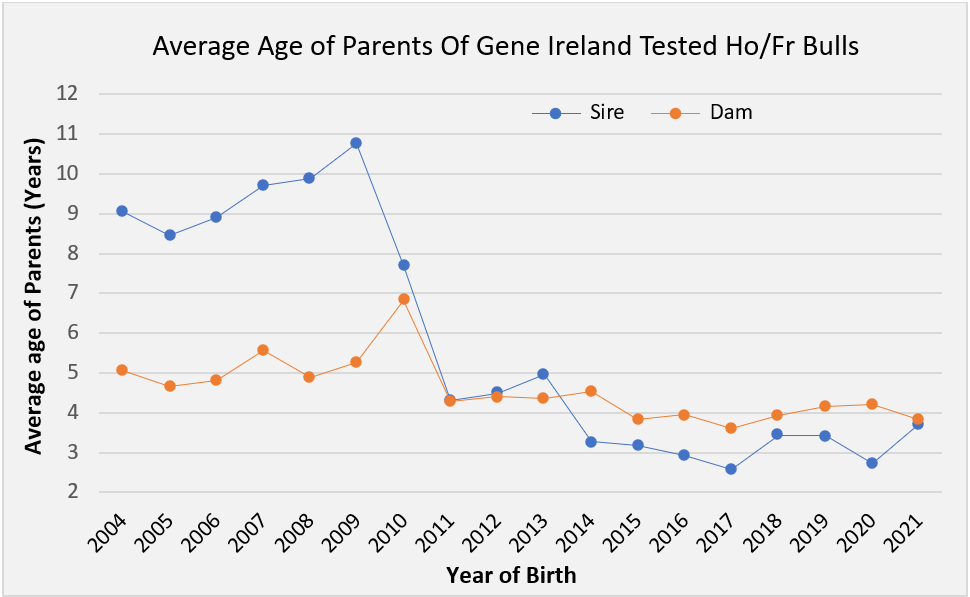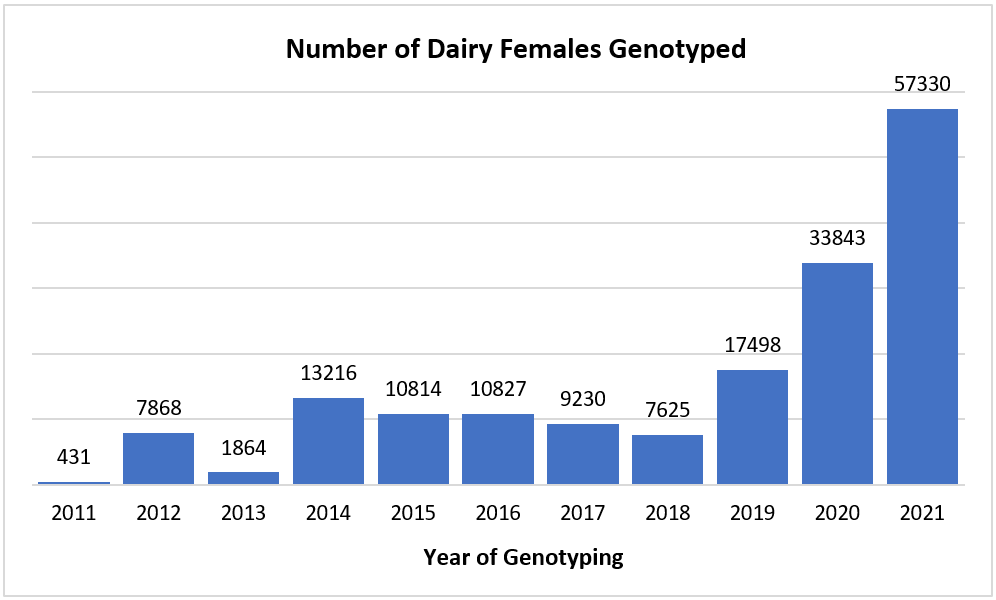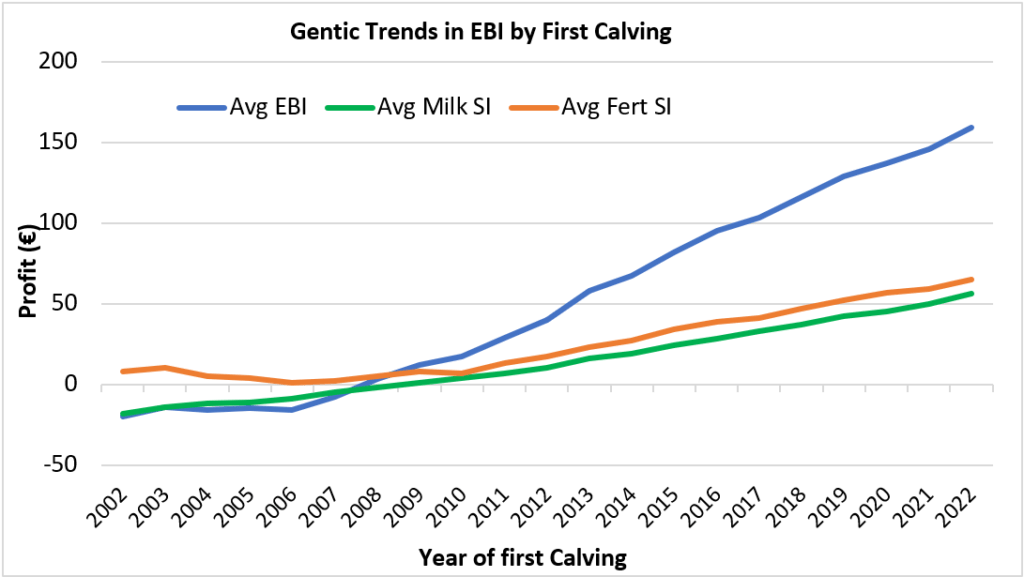Genomic Selection (GS) has made a significant contribution to profitability and sustainability on Irish dairy farms. The technology has transformed the genetic improvement in the national dairy herd and how the Dairy Gene Ireland breeding programme operates. Genomic selection refers to selection decisions based on genomic breeding values.
Genomic testing of dairy bulls has resulted in younger sires, a shorter generation interval and enabled more rapid genetic progress of dairy animals. These factors combined have been estimated to double the rate of genetic gain than traditional progeny testing programmes. Integrating Genomic selection into the breeding programme has also helped the selection for new traits related to the environmental footprint that are not feasible to improve using traditional progeny testing programmes.
Breeding Programme
Prior to the advent of genomics in 2009, AI companies relied on progeny testing to identify bulls with high genetic merit. The only genetic information available was parent average breeding values. This was used to select young bulls and had an accuracy or reliability of 25% to 30%. At about 12 months of age, these young bulls were then mated on farms with the objective of producing approximately 100 daughters. See Table 1 below on the timelines.
Once the bulls had milk recorded daughters on the ground and became daughter proven at 5 years of age, they went for widespread AI use to breed the next generation of replacement heifers and young bulls entering A.I Companies. Traditional progeny testing is time consuming and expensive because the AI companies are waiting a long time to obtain genetic evaluations with necessary accuracy for making selection decisions. The number of bulls evaluated are also limited in traditional progeny testing structures.
Table 1. The Timelines of traditional progeny testing
| Timelines of Traditional progeny Testing | ||||||
| Year -1 | Year 0 | Year 1 | Year 2 | Year 3 | Year 4 | Year 5 |
| Cows served | Bull Calves Bought | Bulls enter G€N€ IR€LAND | Daughters born | Daughters mated | Daughter calves/Milk recorded | Bulls for widespread AI use |
Genomic Selection has allowed the pre-screening of over 10,000 genotyped young bull calves born each year on Irish Farms, with only a small percentage selected for the national breeding programme based on the genomic results. Therefore, genetic gain is increased by screening a massive number of bull calves because this selection intensity is also increased. See table 2 below on the timelines of the genomic based breeding programme. To date, 1,025 bulls have been tested through the Dairy Gene Ireland programme with >538,000 straws disseminated to over 2,600 unique herds.
Table 2. Timeline of Genomic Progeny testing
| Timelines of Genomic Progeny Testing | |||||||
| Year -1 | Year 0 | Year 1 | Year 2 | Year 3 | Year 4 | Year 5 | |
| Cows served | 10,000 Bull calves DNA tested | >80 Bulls enter
G€N€ IR€LAND |
Calves born and bulls chosen for AI |
|
|||
Genomic testing of dairy bulls provides large amounts of reliable information enabling AI companies the ability to carry out accurate selection decisions on potential young bulls prior to purchase, without the need for progeny. Currently, the reliability of genomic evaluations is twice the level of reliability with parent average evaluations. Also, genomics has allowed for the use of younger sires and dams as the parents of the next generation of young bulls. Instead of waiting a minimum of 5 years to use progeny-tested bulls for widespread use, AI companies can use the best DNA-tested young bulls at 2 years of age for widespread use.
Prior to 2009, when bulls were being considered for entry into AI, the average age of their sires and dams were 9.2 years and 5 years respectively. This can be seen below in graph 1, which shows the average of age of parents for Gene Ireland Holstein-Friesian tested bulls by year of birth. For young bulls born in 2021, the average age of their sires were 3.7 years, and the age of their dams were 3.8 years. The average age of their sires and dams has reduced by 60% and 23% respectively. A reduction in the generation interval when the offspring is born translates into more rapid genetic progress.
Graph 1. The Generation Interval trends of Gene Ireland Tested Bulls by year of birth

Genomic evaluations require accurate data collection to establish the reference population to derive genomic predictions and to continually update the reference population. Therefore, Progeny testing is still critically important for the collection of performance data to facilitate the generation of accurate evaluations.
Genomic selection on Dairy Females
The application of Genomic technology on dairy females is rapidly increasing on Irish farms. Many Irish Farmers have embraced genomic selection. There were over 57,000 dairy females genotyped last year compared to 33,843 in 2020 and 17,498 in 2019. This is displayed in graph 2 below. At a herd level, genomic information can be used to make earlier and more informed breeding decisions which ultimately will yield more profitability through greater genetic gain.
Genotyped females can be used in the reference population once they start to gain their own performance information, e.g., calve down and enter milk production. Adding more genotyped cows to reference populations will improve the accuracy of genomic predictions, through increasing the number of animals in the reference population. This will increase genetic gain, as well as ensuring the refence population remains relevant to the current dairy population. The addition of more genotyped cows to the reference population is becoming even more important than before, particularly as the number of bulls added to the reference population on an annual basis is relatively low. There are now over 75,000 and 90,000 cows in the reference population for milk and fertility traits respectively in the October 2022 evaluation. The average gain in reliability for the EBI is 28%, while the gain in reliability for the milk and fertility indexes is 43% and 19% respectively. This is presented in Table 3 and is based on genotyped animals born in 2021 & 2022.
Graph 2. The number of dairy females genotyped per year.

Table 3. The average gain in reliability for the EBI, Milk SI, Fert SI and the individual traits from a non-genomic proof to a genomic proof.

Accelerated Genetic Progress
The greatest impact of genomic selection has been the accelerated rate of genetic gain in the national dairy herd. The annual rates of genetic gain have increased immensely over the last 10 years. The rates of genetic gain have more than doubled prior to the introduction of genomics as shown in graph 3 below. The current rate of genetic gain in EBI is €11/year. With the use of genomic selection of females on-farm also increasing, genetic gain in the Irish national dairy herd is set to increase even further. Genomic selection continues to play a major role on the economic and environmental sustainability of Irish dairy farms now and into the future.
Graph 3. The genetic trend by year of first calving females (2002-2022).

